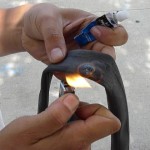 Hot patching, better known as the practice of setting the rubber cement on fire when patching an inner tube, occupies a special place in the folk bicycle wisdom of Detroit. While it lends a touch of magic to the most basic and common form of bicycle repair, instructions for hot patching “properly” are notoriously hard to come by and advice on the subject varies widely depending upon whom one relies for information. As someone who has grown up within the cycling community without any exposure to this practice, I have to admit a certain level of skepticism with regard to hot patching. Years of interaction with street-level bike repair in the Motor City, however, have made the hot patching phenomenon familiar enough to entice me to explore its merits first-hand as a veteran mechanic.
Hot patching, better known as the practice of setting the rubber cement on fire when patching an inner tube, occupies a special place in the folk bicycle wisdom of Detroit. While it lends a touch of magic to the most basic and common form of bicycle repair, instructions for hot patching “properly” are notoriously hard to come by and advice on the subject varies widely depending upon whom one relies for information. As someone who has grown up within the cycling community without any exposure to this practice, I have to admit a certain level of skepticism with regard to hot patching. Years of interaction with street-level bike repair in the Motor City, however, have made the hot patching phenomenon familiar enough to entice me to explore its merits first-hand as a veteran mechanic.
I was first induced to try hot patching by an elderly gentleman who informed me that, contrary to many peoples’ opinion, the rubber cement applied to the tube should be allowed to burn as long as the flammable contents of the cement would allow. Up to that point, I (like countless others) had been under the apparently mistaken pretense that lighting glue on fire would inevitably result in scorched tube rubber. When, to my surprise, I ignited the rubber cement on the inner tube and watched the conflagration expire without any obvious damage to the tube, I realized just how controlled this supposed “witch doctor” remedy can be if done correctly. All at once, the generations of would-be bicycle mechanics who had come to rely on this method of fixing flats were put into their proper perspective: members of a unique do-it-yourself community whose expertise derives from nothing more complex than the quotidian need to get down the road safely and in good repair.
Needless to say, my first couple forays into the world of patching tubes with fire have so far turned out satisfactorily; that is to say, those tubes have continued to hold air flawlessly. As for the elderly gentleman who besought me to trust the hot patch as a legitimate form of tube repair, he has yet to come back to the shop with a flat tire.


It should be noted that modern patch glue or “self-vulcanizing fluid” need not be lit on fire, and is intended to be used without the addition of flame.
I like this tip from an elderly person since I identify with the group that are often (sometimes) called grand – mostly because it takes less time to obtain a sucessful bond between the patch and punctured tube. I have found my lack of patience when waiting for the adhesive to dry in air has resulted in an unsucessful patch. This grandpa hates to slow down! I have also found the time for the glue to dry can be dependent on the relative humidity. I have now added a lighter to my bike repair kit to speed things up.
grandpa mike
A related method is to stretch out a small piece of road tar, use a lighter to get it really melty, and then press it onto the tube. Useful in a pinch, and I rode on such a patch for 500-800 miles before swapping tubes (and not because the patch gave way!).
Good tip, but can you share the details? I assume you scruff the tube, apply the RC, burn it off, then quickly press down/clamp a patch until it cools? Thanks for the help
Hello Sir,
Please tell me. Is there a way of patching an inner tube by just melting rubber around the hole in the tube? Looking forward to your reply. Thank you.
Is it wise to use hot patching for a MOTORCYCLE’S inner tube?
when using an adhesive more is less and a little friction after putting a thin layer over the hole will make it more than tacky enough to adhere to a patch. my current rear tube has had a park tool patch on it for close to a thousand miles now with no leakage.
i guess lighting it on fire might speed up the process but my experience is 5-10 minutes total isnt that long anyhow.